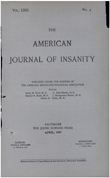A STUDY OF THE NEUROFIBRILS IN DEMENTIA PARALYTICA, DEMENTIA SENILIS, CHRONIC ALCOHOLISM, CEREBRAL LUES AND MICROCEPHALIC IDIOCY
Abstract
It has been indicated throughout this paper that great caution must be exercised in the interpretation of the alterations which the neurofibrils present in material from pathological sources, a caution which in the light of our present knowledge cannot be too strongly emphasized. The writer believes, nevertheless, from a study of these 14 cases and 40 others which have been examined in the laboratory of the Westborough Insane Hospital but not reported, and after due consideration of the objections which have been raised, that alterations in the neurofibrils which might well be considered pathological, may be demonstrated in the cerebral cortex of persons dying insane.
(a) The alterations in the neurofibrils when taken alone do not appear to have any greater value for diagnostic purposes than the mere disintegration of the tigroid masses in a Nissl preparation.
(b) The poverty in cell processes the more or less universal tinging of the nucleus and destruction of the finer intercellular fibrils characterize the silver impregnation of the dementia paralytica cortex, whereas fair preservation of the dendrites and an equally diffuse destruction of intercellular fibrils, but without special preference for the finest elements, is the rule in dementia senilis.
(c) The alterations in the remaining groups of cases reported suggest that these changes may be due to a variety of causes, such as œdema, faulty nutrition or development and the direct action of intoxications introduced from without.
(d) Alterations in the neurofibrils such as granular disintegration, fragmentation, localized swellings, rarefaction and complete destruction were to be found in varying stages of intensity in all of our cases.
(e) Just as the ensemble in a Nissl preparation is of value in determining a dementia paralytica or in differentiating a luetic meningeal or perivascular infiltration, in almost to the same degree may the sum of the findings in a silver impregnation for neurofibrils be employed in making an anatomical diagnosis of dementia paralytica, or in differentiating it from a disease with a dystrophic substratum such as dementia senilis.
Access content
To read the fulltext, please use one of the options below to sign in or purchase access.- Personal login
- Institutional Login
- Sign in via OpenAthens
- Register for access
-
Please login/register if you wish to pair your device and check access availability.
Not a subscriber?
PsychiatryOnline subscription options offer access to the DSM-5 library, books, journals, CME, and patient resources. This all-in-one virtual library provides psychiatrists and mental health professionals with key resources for diagnosis, treatment, research, and professional development.
Need more help? PsychiatryOnline Customer Service may be reached by emailing [email protected] or by calling 800-368-5777 (in the U.S.) or 703-907-7322 (outside the U.S.).



